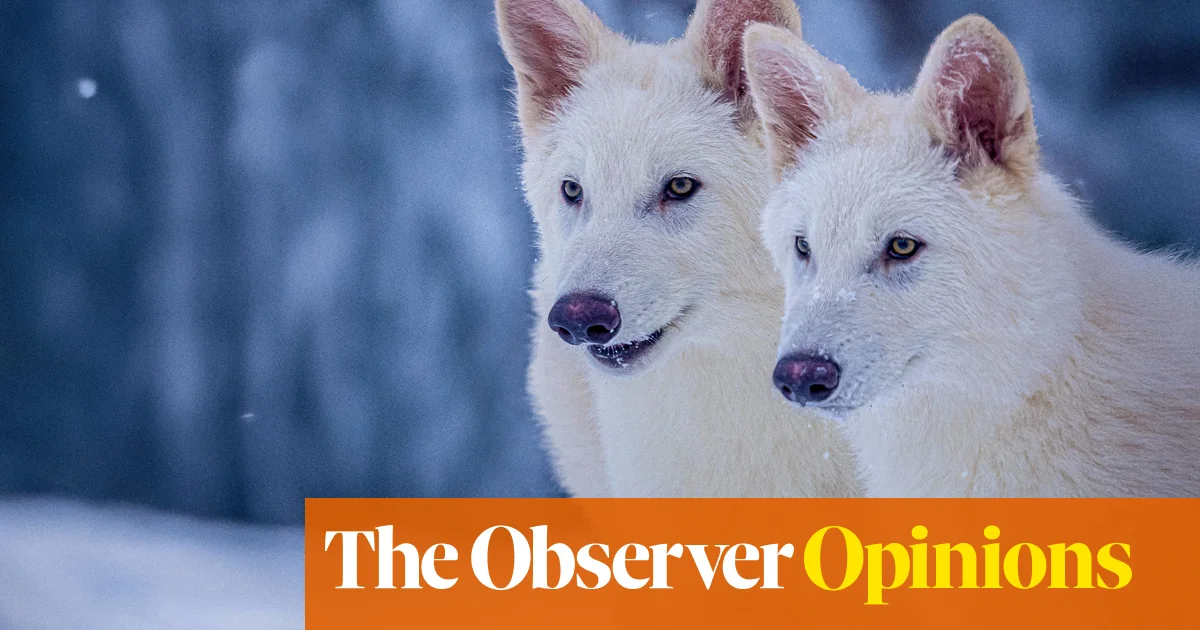The parable of the Mars mission: we’d rather spend trillions sending ourselves to a yet unlivable planet than look after the one we have. And swiftly on its heels, the parable of the dire wolf. We’d rather resurrect a 12,500-year-old species from the dead than save our existing wild animals. Of course we would. Recycling is boring; doing the very thing 90s science fiction movies warned us not to do is fun.
We are not quite on the verge of bringing back ancient species. But last week the PR campaign for doing so began in earnest. Colossal Biosciences – a company known for trying to revive the dodo, the mammoth and the thylacine – has unveiled three large adorable white puppies, claiming it has created “the world’s first successfully de-extincted animal”: the dire wolf, made famous by Game of Thrones. It invited author George RR Martin to look; he duly burst into tears.
Scientists have been quick to point out that the company hasn’t done anything of the sort: it has instead created a new animal altogether – a larger, whiter, more muscly wolf. To do so, researchers made edits to the grey wolf genome, and then implanted the resulting embryos in large dogs, extracting them by caesarean section. The puppies look like dire wolves, but what gives the project away is the fact that this is down to just 20 gene edits made on a genome of billions of bases – which makes them closer to the grey wolf than anything else.
There is little point bringing back an animal if we simply drive it to extinction again
Still, it’s a tremendous achievement, and was announced alongside another: the company has cloned four red wolf pups, a species with fewer than 20 in the wild. This could help to revive their thinning population. Does this herald a solution to declining biodiversity and dying ecosystems?
Not quite yet. Let’s start with the obvious ethical problem: the welfare of these animals. The first generation of an extinct species will arrive without kin. Wolves are sociable creatures, but the three novel pups have no pack to join, and no parents to teach them how to survive and thrive. Nor can they be released into their natural habitat, as it no longer exists. Colossal plans to keep the three “dire wolves” in (spacious) captivity for their whole life – there is of course no other solution. They will not be allowed to breed. In fact, it is hard to imagine a future for ancient animals like the dire wolf that doesn’t involve life in a zoo, kept as exotic curiosities.
At this point some employ the brutal argument zoos often do: the suffering of these animals has a greater purpose; sacrificing the welfare of a few charismatic creatures will indirectly help others. Just as keeping animals on pitiful display supposedly drives enthusiasm for conservation, so excitement over a resurrected mammoth might attract funding, advancing technology that could be repurposed for worthier efforts, such as bolstering populations of endangered animals and plants.
But it’s a bargain that doesn’t add up. You do not need to recreate the dire wolf or the dodo in order to work on the red wolf. And shouldn’t the imminent extinction risk of swathes of creatures be motivation in itself? Are we such children that we need zoos and Game of Thrones to tempt us into saving the planet?
Would de-extinction work, even in the most promising cases? Let’s say we dispensed with the ridiculous project of reviving long-dead creatures and focused our efforts on animals that went extinct recently, for whom some habitat remains.
Two problems stand in our way. First, it is incredibly hard to release captive-bred animals, which do not know how to survive in the wild. Humans have not yet learned to train them in artificial environments – and we may never work out how.
Second: there is little point bringing back an animal if we simply drive it to extinction again. Most animals die out because of climate change and the destruction of ecosystems. De-extinction is not an alternative to conservation – we would have to do both.
skip past newsletter promotion
Sign up to Observed
Analysis and opinion on the week’s news and culture brought to you by the best Observer writers
Privacy Notice: Newsletters may contain info about charities, online ads, and content funded by outside parties. For more information see our Privacy Policy. We use Google reCaptcha to protect our website and the Google Privacy Policy and Terms of Service apply.
after newsletter promotion
Which brings us to the most important argument against de-extinction: the “opportunity costs”, or the benefits that could be lost by supporting it. It may be better to spend on the living than the dead. A study published in Nature has calculated that maintaining a population of resurrected animals would be so expensive that two species would die out for every one revived, should the money come out of government conservation budgets. If private money were redirected from de-extinction to conservation, two to eight times more species could be saved. In other words, if Colossal wants to “fix extinction”, its enormous budget and technological genius would be better employed saving orangutans, blue whales and mountain gorillas.
In fact, the opportunity costs may be starker: critics have warned that the idea we can bring back species will undermine conservation. They were swiftly proved right. Trump’s administration hailed Colossal’s claims to argue for slashing endangered species protections. “Going forward, we must celebrate removals from the endangered list – not additions,” US interior secretary Doug Burgum has said. “If we’re going to be in anguish about losing a species, now we have an opportunity to bring them back. Pick your favourite species and call up Colossal.”
Martha Gill is an Observer columnist
